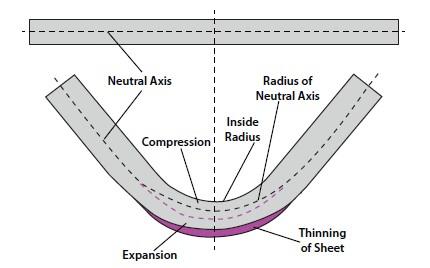Determine Natural Bend Of Sheet Aluminum

The material thickness will be measured in decimal form not by the gauge number.
Determine natural bend of sheet aluminum. Determine your minimum bend by measuring the distance from your closest feature i e. Cut the section of metal out or otherwise prepare the metal to be bent by removing any burrs or sharp edges. Since commercial sheet metal bending can be done with less concern for stresses caused during forming operation the radius can be near zero for thin sheet metal. The bend allowance formula takes into account the geometries of bending and the properties of your metal to determine the bend allowance.
When bending aluminum know that the smaller your inside bend radius the larger the chance that cracking will occur in the part. The bend radii listed are standard minimum if manufacturing for aircraft and aerospace applications. General advice on aluminum. 90 degrees bend angle.
If you re bending 0 020 thick material use a 0 020 radius. This measurement will be necessary for calculating your bend allowance. Figure 2 illustrates the sheet that is bent with the bend angle of 90 degrees. A cutout or the edge of your flange to your bend.
The minimum bend radius data shown in these charts is measured to the inside of the bend. We will start by calculating the bend allowance. After bending the sheet we need to do some measurements as shown in figure 2. You can use a tape measure or ruler to measure the thickness of your sheet metal.
Determine the thickness of your sheet. Bend allowance calculator the bend allowance and bend deduction are two measures that relate the bent length of a piece of sheet metal to the flat length. You will need to know your material thickness mt the bend angle b the inside radius ir and the k factor k. Cells on the right will output the desired values.
If you have any questions or want to discuss your design contact us. In other words if you re bending 1 8 sheet use a tool with a 1 8 radius to form the inside of the bend. Choose a bend radius that matches your minimum bend. If your sheet metal is too thick you may need special machinery like a brake or a torch to bend your sheet into the desired shape.
From there we can calculate the k factor and the bend deduction. Also know that for the best results and fewer cracks on the outside of the bend the bend line should go across or diagonal to the material grain when and where possible. For most applications with stainless steel or aluminum you can get away with a zero radius bend on anything under 0 050 thick. You will use the protractor to gauge the brake as you bend the metal little by little.
You only have to insert interior angle flange lengths k factor inside radius and material thickness.



















.jpg)


























